Solar Eclipse Of February 25, 1952
A total solar eclipse occurred on February 25, 1952.
A solar eclipse occurs when the Moon passes between Earth and the Sun, thereby totally or partly obscuring the image of the Sun for a viewer on Earth. A total solar eclipse occurs when the Moon's apparent diameter is larger than the Sun's, blocking all direct sunlight, turning day into darkness. Totality occurs in a narrow path across Earth's surface, with the partial solar eclipse visible over a surrounding region thousands of kilometres wide. The path of totality crossed Africa, the Middle East, and Asia.
| Solar eclipse of February 25, 1952 | |
|---|---|
| Type of eclipse | |
| Nature | Total |
| Gamma | 0.4697 |
| Magnitude | 1.0366 |
| Maximum eclipse | |
| Duration | 189 s (3 min 9 s) |
| Coordinates | 15°36′N 32°42′E / 15.6°N 32.7°E |
| Max. width of band | 138 km (86 mi) |
| Times (UTC) | |
| Greatest eclipse | 9:11:35 |
| References | |
| Saros | 139 (26 of 71) |
| Catalog # (SE5000) | 9402 |
Related eclipses
Solar eclipses of 1950–1953
This eclipse is a member of a semester series. An eclipse in a semester series of solar eclipses repeats approximately every 177 days and 4 hours (a semester) at alternating nodes of the Moon's orbit.
| Solar eclipse series sets from 1950 to 1953 | ||||||
|---|---|---|---|---|---|---|
| Ascending node | Descending node | |||||
| Saros | Map | Saros | Map | |||
| 119 |  1950 March 18 Annular (non-central) | 124 |  1950 September 12 Total | |||
| 129 |  1951 March 7 Annular | 134 |  1951 September 1 Annular | |||
| 139 |  1952 February 25 Total | 144 |  1952 August 20 Annular | |||
| 149 |  1953 February 14 Partial | 154 | 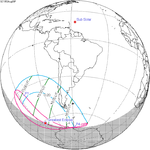 1953 August 9 Partial | |||
| Solar eclipse of July 11, 1953 belongs to the next lunar year set | ||||||
Saros 139
This eclipse is a member of saros series 139, repeating every 18 years, 11 days, 8 hours, containing 71 events. The series started with partial solar eclipse on May 17, 1501. It contains hybrid eclipses on August 11, 1627, through to December 9, 1825; and total eclipses from December 21, 1843, through to March 26, 2601. The series ends at member 71 as a partial eclipse on July 3, 2763. Its eclipses are tabulated in three columns; every third eclipse in the same column is one exeligmos apart, so they all cast shadows over approximately the same parts of the Earth.
The solar eclipse of June 13, 2132, will be the longest total solar eclipse since July 11, 1991, at 6 minutes, 55.02 seconds.
The longest duration of totality will be produced by member 39 at 7 minutes, 29.22 seconds on July 16, 2186. After that date, the durations of totality will decrease until the series ends. This date is the longest solar eclipse computed between 4000 BC and AD 6000. Saros series eclipses occur during the Moon's ascending node (a term related to our equator and polar-naming conventions).
| Series members 24–45 occur between 1901 and 2300 | ||
|---|---|---|
| 24 | 25 | 26 |
 February 3, 1916 |  February 14, 1934 |  February 25, 1952 |
| 27 | 28 | 29 |
 March 7, 1970 |  March 18, 1988 |  March 29, 2006 |
| 30 | 31 | 32 |
 April 8, 2024 |  April 20, 2042 |  April 30, 2060 |
| 33 | 34 | 35 |
 May 11, 2078 |  May 22, 2096 |  June 3, 2114 |
| 36 | 37 | 38 |
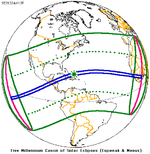 June 13, 2132 |  June 25, 2150 | 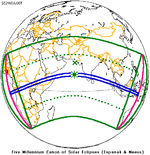 July 5, 2168 |
| 39 | 40 | 41 |
 July 16, 2186 | 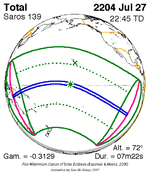 July 27, 2204 | 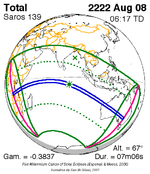 August 8, 2222 |
| 42 | 43 | 44 |
 August 18, 2240 |  August 29, 2258 |  September 9, 2276 |
| 45 | ||
 September 20, 2294 | ||
Metonic series
The metonic series repeats eclipses every 19 years (6939.69 days), lasting about 5 cycles. Eclipses occur in nearly the same calendar date. In addition, the octon subseries repeats 1/5 of that or every 3.8 years (1387.94 days).
| 22 eclipse events between December 13, 1898 and July 20, 1982 | ||||
|---|---|---|---|---|
| December 13–14 | October 1–2 | July 20–21 | May 9 | February 24–25 |
| 111 | 113 | 115 | 117 | 119 |
 December 13, 1898 |  July 21, 1906 |  May 9, 1910 |  February 25, 1914 | |
| 121 | 123 | 125 | 127 | 129 |
 December 14, 1917 |  October 1, 1921 |  July 20, 1925 |  May 9, 1929 |  February 24, 1933 |
| 131 | 133 | 135 | 137 | 139 |
 December 13, 1936 |  October 1, 1940 |  July 20, 1944 |  May 9, 1948 |  February 25, 1952 |
| 141 | 143 | 145 | 147 | 149 |
 December 14, 1955 |  October 2, 1959 |  July 20, 1963 |  May 9, 1967 |  February 25, 1971 |
| 151 | 153 | 155 | ||
 December 13, 1974 |  October 2, 1978 |  July 20, 1982 | ||
Notes
References
- Earth visibility chart and eclipse statistics Eclipse Predictions by Fred Espenak, NASA/GSFC
- Solar eclipse of February 25, 1952 in Russia Archived January 3, 2010, at the Wayback Machine
This article uses material from the Wikipedia English article Solar eclipse of February 25, 1952, which is released under the Creative Commons Attribution-ShareAlike 3.0 license ("CC BY-SA 3.0"); additional terms may apply (view authors). Content is available under CC BY-SA 4.0 unless otherwise noted. Images, videos and audio are available under their respective licenses.
®Wikipedia is a registered trademark of the Wiki Foundation, Inc. Wiki English (DUHOCTRUNGQUOC.VN) is an independent company and has no affiliation with Wiki Foundation.
